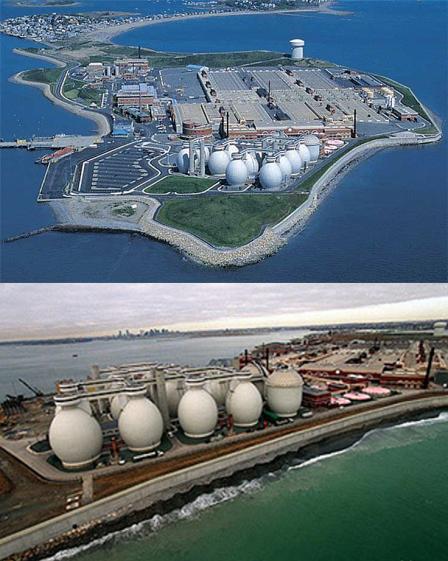Boston Raises Wastewater Facility to Avoid Inundation
 A view of Boston’s Deer Island Wastewater Treatment Plant’s redesigned facilityIn the late 1980’s, Boston’s Deer Island Wastewater Treatment Plant needed an upgrade. The Massachusetts Water Resources Authority (MWRA) determined facility vulnerability to sea level rise and decided to raise key portions of the plant by 1.9 feet. The redesign and construction covered a ten year period (1989-1998) and was part of a $3.8 billion upgrade to add secondary treatment and consolidate regional treatment capacity by increasing Deer Island capacity from 250 to 350 million gallons for day.
A view of Boston’s Deer Island Wastewater Treatment Plant’s redesigned facilityIn the late 1980’s, Boston’s Deer Island Wastewater Treatment Plant needed an upgrade. The Massachusetts Water Resources Authority (MWRA) determined facility vulnerability to sea level rise and decided to raise key portions of the plant by 1.9 feet. The redesign and construction covered a ten year period (1989-1998) and was part of a $3.8 billion upgrade to add secondary treatment and consolidate regional treatment capacity by increasing Deer Island capacity from 250 to 350 million gallons for day.
MWRA’s decision to raise portions of the plant avoided extensive costs associated with building a seawall and covered the projected vulnerability over the planned life of the facility (through 2050). MWRA considers the vulnerability of its facilities on an on-going basis using current information to assess the effectiveness of its climate adaptation actions.
The Deer Island adaptation action has been re-evaluated for effectiveness within the city’s Comprehensive Adaptation Plan (“Climate Ready Boston", 2013). This review used a community non-profit’s sea level rise study and concluded that MWRA’s decision to raise Deer Island is likely to be sufficient to avoid inundation of the facility over the next century.
- “Climate Ready Boston (PDF)", 2013 (29 pp, 7.17 MB, About PDF) Exit
| How Did They Do It? | Applicable EPA Tools |
|---|---|
MWRA identified facility vulnerability
|
The Climate Resilience Evaluation and Awareness Tool (CREAT) helps understand expected utility facility vulnerabilities from a changing climate. |
MWRA adapted to future conditions
|
EPA’s Creating Resilient Water Utilities Adaptation Strategies Guide, assists utilities identify potential facility adaptation strategies based upon expected climate vulnerabilities. |
As science improves, MWRA re-evaluates risk and vulnerabilities to ensure effective adaptation
|
The EPA Coastal Inundation Toolkit can assist utilities in better understanding facility vulnerability by illustrating a range of potential sea level rise and storm surge scenarios. |
Similar Cases and More Information
Sea-level rise is only one impact from climate change. Climate projections are typically best considered as a range of likely impacts based on best available science. To see how a community conducted their own vulnerability analysis to sea-level rise, not relying on external analyses, view Manchester-by-the-Sea. Retrofitting is not the only adaptation strategy for utilities dealing with projected increased flooding, two other strategies utilities can consider are building a wall to protect facilities from higher water levels (DC Blue Plains) and decommissioning flood-prone facilities (Iowa City, IA) decommissioned a highly flood-prone wastewater facility. For more on how Boston is adapting to climate change, view Climate Ready Boston.

